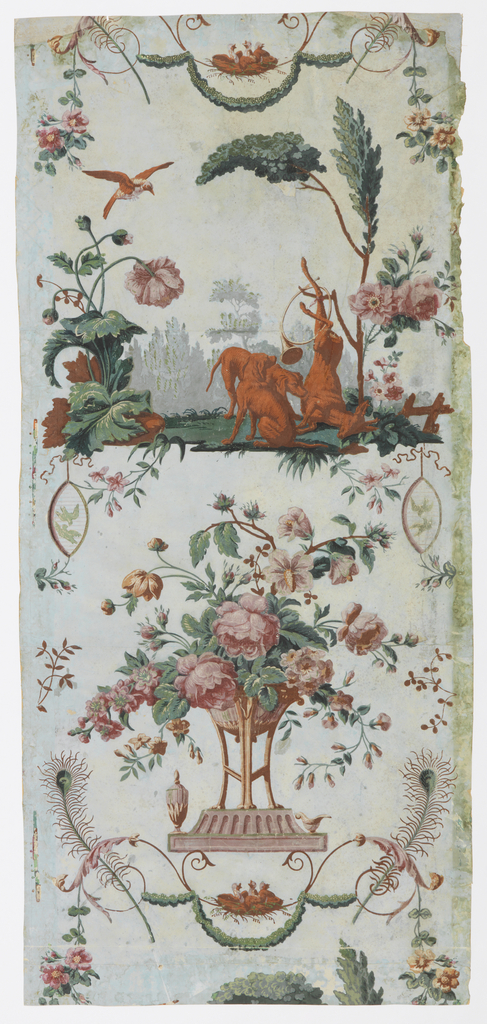There is ALOT going on in this arabesque panel attributed to eighteenth-century wallpaper powerhouse, Jean Baptiste Réveillon. The pattern was executed in shades of pink, green, orange and brown on a light-colored ground. As was standard for the time, the design is block printed, and the panel is composed of several smaller sheets of handmade paper that have been joined together. Two scenic medallions alternate, bordered by festoons of greenery, peacock feathers, fanciful scrolls and nests full of chirping baby birds. The first medallion depicts two grumpy-looking hounds keeping watch over a dead deer, the trophy of the most recent hunt, made known by his suspension from the tree with the hunting horn. Some oversized pink flowers and a curious bird observe from the edges, while a nest with hungry hatchlings is portrayed above. The second medallion features a nice bouquet of orange and pink roses, and seems rather mundane when compared to the odd hunting scene above and below.
Réveillon was a character as colorful and varied as the wallpaper he produced. He was able to establish himself in the industry by using his wife’s ample dowry to manufacture flocked papers beginning in the 1750s. Patronized by the elite of the Ancien Régime, he amassed an incredible fortune which was used to purchase a mansion containing a theater, launch the world’s first hot air balloons, and stock a gigantic wine cellar. Unfortunately, in 1789 his grand property was overrun by an angry mob who were incised by a rather tactless comment made by M. Réveillon in regards to the price of bread. Though the Monsieur escaped to England with his family and fortune, the contents of the wine cellar were completely annihilated by thirsty rioters.
Anna Rasche is a student in the History of Decorative Arts & Design graduate Program at the Cooper Hewitt, and is a Master’s Fellow in the Wallcoverings Department.
References:
https://collection.cooperhewitt.org/people/18046439/bio#wk

One thought on “An Arabesque by the Best”
Robert M. Kelly on September 10, 2016 at 10:30 am
This is not a panel, though it is a sidewall, according to the classification system devised by Bernard Jacque in his book about arabesques: Le Papier Peint En Arabesques. Paris: Editions de la Martiniere, 1995. According to this system, Type I are panels. Usually those are wide. Type II are pilasters, usually narrow.
The other two types are sidewalls. Type III are what you see above, a drop-match single course of alternating vertical motifs. And Type IV are double-course sidewalls. Jacque found that the single course designs were always drop matches (sauté), and that the double-course designs were invariably straight-across matches.
“Sauté” in itself means “jump”. The word relates to the way that onions jump in a frying pan. A “jump” match, then, is a drop match.